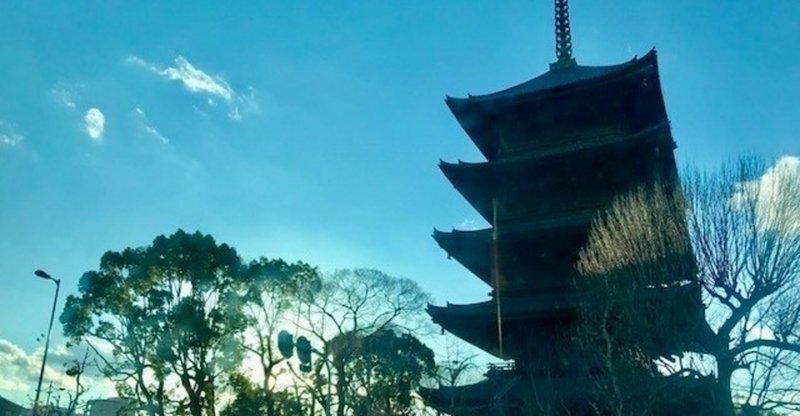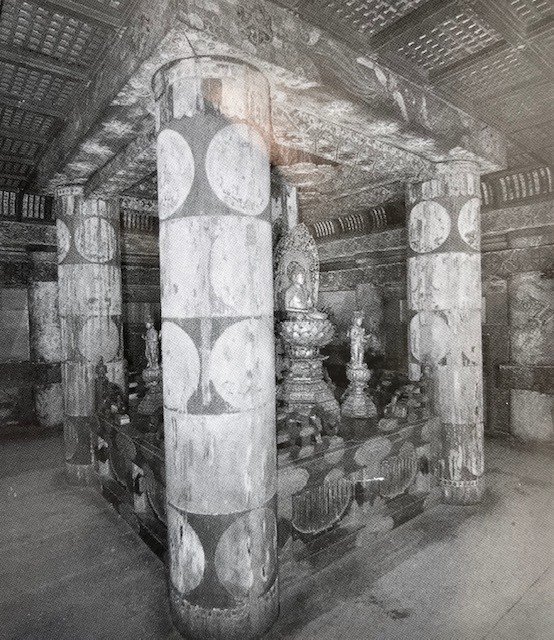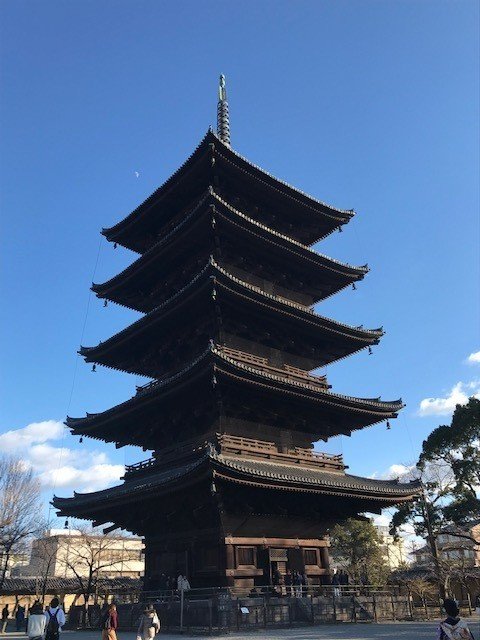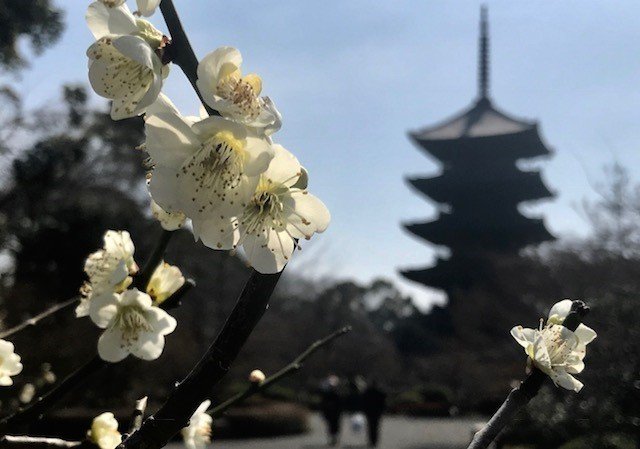
五重塔は仏教美術の粋をきわめたものである。【日本の美シリーズⅢ】 The five-storied pagoda is a fine example of Buddhist art.
日本の美の一つとして表現されているのが「五重塔」である。ご存じのように、奈良の法隆寺、室生寺、興福寺、そして京都の東寺、醍醐寺の五重塔は国宝に指定されている。ちなみに法隆寺や東寺、醍醐寺は世界遺産である。
その中で、よく訪ねるのが東寺で、行けば必ず五重塔にすり寄っていく。通常は内部を見ることはできないが、季節の特別拝観のときに石段をあがり四方の扉から順番に見せていただくことがある。なんと不思議な世界観をもつ建造物であることは言うまでもない。
The "five-storied pagoda" is expressed as one of the beauty of Japan. As you know, Horyu-ji Temple, Muro-ji Temple, Kofuku-ji Temple in Nara, and the one of To-ji Temple and Daigo-ji Temple in Kyoto are designated as national treasures. And also, Horyu-ji Temple, To-ji Temple and Daigo-ji Temple are one of World Heritage Sites.
Among them, I often visit To-ji Temple, and when I go there I will definitely go to the five-storied pagoda. Normally, the inside cannot be seen, but during special seasonal visits, the doors are displayed in order from the four sides. It goes without saying that it is a building with a mysterious world view.
五重塔を含む多重塔は、多宝塔とはちがう宗教観のある建物と考えられているようだ。石造仏塔と同じように、下から「地」(基礎)、「水」(塔身)、「火」(笠)、「風」(請花)、「空」(宝珠)からなっている。それぞれ五つの世界、つまり五大思想を示し、仏教的な宇宙観を表しているといわれている。
塔の全体が、仏教思想を表現している建物になるのだろう。あの器に思想の全てが網羅されているといっても過言ではないだろう。形状や内部構造、そして納められている全てのもの一つ一つが仏教思想的役割を果たしていると言えるのだろう。
The multi-storied pagoda including the five-storied pagoda seems to be considered a building with a different religious view. Like the stone stupa, it consists of "ground", "water", "fire", "wind", and "sky" from the bottom. It is said that each represents five worlds, that is, the five major thoughts, and represents a Buddhist view of the universe.
The whole tower will be a building expressing Buddhist thought. It would be no exaggeration to say that all of the ideas are covered in that vessel. It can be said that the shape, internal structure, and everything contained in it all play a Buddhist ideological role.

東寺五重塔初層内部 / inside of the five-storied pagoda
たとえば、京都 東寺の五重塔は、各層を貫いている心柱(しんばしら)は、大日如来としての役割をもっている。その周りを四尊の如来(阿閦如来・室生如来・阿弥陀如来・不空成就如来)の如来、八尊の菩薩が囲んでいる。さらに、四方の柱に金剛界曼荼羅が描かれている。心柱はすべてにおいて中心的役割を果たす、塔の心臓部と脊髄部となるのである。
For example, the five-storied pagoda at To-ji Temple in Kyoto has Shinbashira, which runs through each layer, as a Dainichi Nyorai. Surrounded by it are the Buddhas of Shison and the Buddha of Shison (Ajyari Nyorai, Muro Nyorai, Amitabha Nyorai, Fukujyojyu Nyorai). Furthermore, Kongokai Mandala is drawn on the four pillars. The pillar is the heart and spinal column of the tower, which plays a central role in everything.

東寺五重塔 / five-storied pagoda of the To-ji
心柱は、地下に埋めこみ上に伸びているもの。地上の基礎部に置いてあるのもあり、また上層部からつり下げ地上には接してない心柱も多い。法隆寺の五重塔は地面に埋設された堀立式、薬師寺東塔は礎石の上に立てる礎石式。東寺は懸垂式といわれ、塔から心柱を鎖でつないで宙吊りになっている。それぞれ違いには諸説あるようだ。
The pillar is embedded underground and extends upward. There are also pillars on the ground, and there are many pillars that are suspended from the upper layers and are not in contact with the ground. The five-storied pagoda of Horyu-ji is a horitachi type buried in the ground, and the Yakushi-ji east pagoda is a foundation stone type erected on a foundation stone. To-ji is said to be suspended, and the pillars are suspended from the tower by chains. It seems that there are various theories regarding the differences.
五重塔は、地震の力を柔軟な構造を用いて吸収することにより、建築物の破壊を防ぐ柔構造が用いられている。それは心柱が地震の力を吸収し、また階層の庇が大きく瓦などの重みが、地震の力を下に逃がしていく仕組みになっている。初層にはその力を吸収しても耐えられる心柱を囲む4本の柱が支えている。
The five-storied pagoda has a flexible structure that prevents the destruction of buildings by absorbing the force of the earthquake using a flexible structure. It has a mechanism in which the pillar absorbs the force of the earthquake. The eaves of the each floor are large, and the weight of the roof tiles and so that they releases the force of the earthquake downward. The first layer is supported by four pillars surrounding a pillar that can withstand the force.


東寺の風景 / To-ji's Landscape
千年前にこれだけの優れた建築技法が生み出され駆使されていたことを想像すると、歴史に対する見方が変わってくる。その中から美意識が生まれ「日本の美」の礎になっているように思える。機能と形状が一体となって美観が生み出されている。つまり、構造と形、そしてその周辺の景観を含む、日本の伝統造形は仏教思想を忠実に表しているといえるだろう。
Imagine that such an excellent architectural technique was created and used a thousand years ago, and your view of history will change. From that, it seems that aesthetic sense was born and is the cornerstone of "Japanese beauty." The function and shape are combined to create an aesthetic appearance. In other words, it can be said that traditional Japanese art, including structure and shape, and the scenery around it, faithfully represents Buddhist thought.
よろしければサポートお願いします。日本の伝統文化に関心を寄せています。若いころに文化圏の異なる地域の方たちとの交流で日本のことをあまりにも知らなかったことに気づかされ、それがきっかけで広く浅く学んでいます。拙いレポートですが、お目に留めていただければ幸です。
